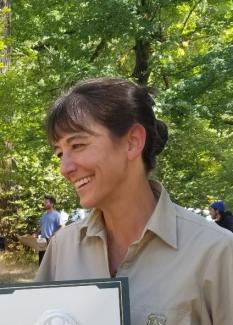Protecting Our Forests and Communities
Emily Platt, Forest Supervisor, Region 1/Helena-Lewis and Clark NF
May 3rd, 2023

For many of our central Montana communities, the unseasonably early wildfire smoke from Canada brings heightened anticipation of the fire year to come. As the forest supervisor of the Helena-Lewis and Clark National Forest, I have the honor to oversee the management of nearly 2.9 million acres of public lands from the Bob Marshall Wilderness Complex through Lincoln and Helena and east to the Snowy Mountains. Having spent over a decade studying and working on fire and landscape resilience issues within similar forests and communities, I understand the benefits that fire can bring, and the concerns people may have. Over the last few decades, our understanding of wildfire in the west has made it clear that we need to get fire back on the land under the right weather conditions to reduce expensive and severe wildfires. By reducing fuels and introducing more prescribed fire, we invest in protecting forests, our homes and communities, drinking water, and our favorite places to recreate. If we don’t expand the amount of fire we introduce under the right weather conditions, a heavier burden is passed down to taxpayers and communities in terms of continued wildfire impacts.
Managing fuels – or the things a wildfire would burn – is our best chance to change how a wildfire impacts the land. Prescribed fire is the most effective way to reduce fuels, both surface fuels (e.g. grasses and pine needles) and ladder fuels (e.g. small trees or branches on trees near the ground) that carry fire across the landscape. Historically, frequent wildfires would have removed many thousands of small trees, but the impressive effectiveness of our suppression work has led to dense forested areas where it is neither safe nor effective to use prescribed fire. In these situations, we can thin forests before we reintroduce fire. A combination of thinning or mechanical fuels reduction along with prescribed fire is our best bet to reduce the size and severity of wildfire while protecting our forests and communities.
We’re fortunate to have exceptional partners with whom we plan and implement projects that make a real difference on the ground. For many years now we have worked closely with partners on the Capital 360 Project to accomplish fuels reduction work around Helena. This work is a great investment for taxpayers as it not only protects the city of Helena and homes but also helps protect the Ten Mile Creek Watershed, Helena’s primary drinking water source. Additional partners in this work include the Montana Department of Natural Resources and Conservation; Tri-County FireSafe Working Group; Natural Resource Conservation Service; Bureau of Land Management; Lewis and Clark, Broadwater, and Jefferson Counties; the City of Helena; and local fire districts and residents.
We are also working with partners and have collectively obtained over $7 million in funding for the Elkhorn Range to carry out work that will foster more resilient forests and landscapes. Starting this summer, meadow and shrubland restoration, the reintroduction of fire, and weed mitigation efforts will improve wildlife habitat and restore grasslands to more historical conditions leading to more resilient landscapes and enhanced recreational opportunities, such as hunting and hiking.
We are combining these focused projects with innovative, landscape-scale work. One project we’re particularly excited about is our forest-wide prescribed fire project. The idea is to analyze the introduction of prescribed fire across the Helena-Lewis and Clark National Forest so that when narrow windows of opportunity arise, we can take advantage of just the right weather and forest conditions to reduce the risk of catastrophic outcomes when wildfires hit under untenable weather conditions. You can visit our projects page to learn more. We anticipate a comment period on the environmental assessment sometime this fall.
Fuels reduction and prescribed fire mean safer communities, and a safer, more effective response for fire personnel. This work would not be possible without our industry, government, NGO and community partners – thank you. And we are always open to hearing from you about what you value about our national forestlands and how we can better serve the community. Feel free to reach out anytime to let us know what you think.
Learn more!
Capital 360 project in the Helena-area:
Elkhorns:

Emily Platt, PhD, Forest Resources, Oregon State University College of Forestry
Forest Supervisor, Helena-Lewis and Clark NF
May 2023


